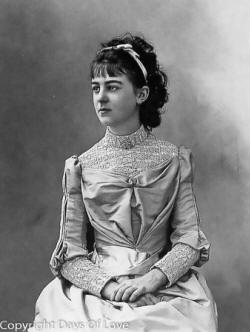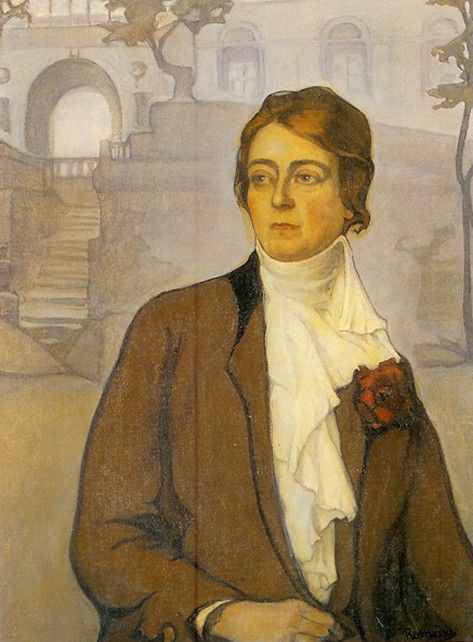

Partner Natalie Clifford Barney
Queer Places:
Hôtel de Craon, Place de la Carrière, 54000 Nancy, Francia
Château de Vallière, 60128 Mortefontaine, Francia
Château d’Ancy-le-Franc, 18 Place Clermont-Tonnerre, 89160 Ancy-le-Franc, Francia
 Antoinette
Corisande Élisabeth, Duchess of Clermont-Tonnerre (née de Gramont; 23 April
1875 – 6 December 1954) was a French writer of the early 20th century, best
known for her long-term lesbian relationship with
Natalie Clifford Barney, an American writer. Élisabeth de Gramont had
grown up among the highest aristocracy; when she was a child, according to
Janet Flanner,
"peasants on her farm... begged her not to clean her shoes before entering
their houses". She looked back on this lost world of wealth and privilege with
little regret, and became known as the "red duchess" for her support of
socialism. Djuna Barnes wrote a lively
bagatelle called Ladies Almanack in 1928.
Natalie Barney
featured here as Dame Evangeline Musset;
Romaine Brooks as Cynic Sal;
Lily de Gramont as the Duchesse
Clitoressa of Natescourt;
Una Troubridge
as Lady Buck-and-Balk; Radclyffe Hall
as Tilly Tweed-in-blood; Mina Loy as
Patience Scalpel; Mimì Franchetti
as Senorita Fly-About; and Janet
Flanner and Solita Solano as
Nip and Tuck. The book was privately published by
Robert McAlmon.
Antoinette
Corisande Élisabeth, Duchess of Clermont-Tonnerre (née de Gramont; 23 April
1875 – 6 December 1954) was a French writer of the early 20th century, best
known for her long-term lesbian relationship with
Natalie Clifford Barney, an American writer. Élisabeth de Gramont had
grown up among the highest aristocracy; when she was a child, according to
Janet Flanner,
"peasants on her farm... begged her not to clean her shoes before entering
their houses". She looked back on this lost world of wealth and privilege with
little regret, and became known as the "red duchess" for her support of
socialism. Djuna Barnes wrote a lively
bagatelle called Ladies Almanack in 1928.
Natalie Barney
featured here as Dame Evangeline Musset;
Romaine Brooks as Cynic Sal;
Lily de Gramont as the Duchesse
Clitoressa of Natescourt;
Una Troubridge
as Lady Buck-and-Balk; Radclyffe Hall
as Tilly Tweed-in-blood; Mina Loy as
Patience Scalpel; Mimì Franchetti
as Senorita Fly-About; and Janet
Flanner and Solita Solano as
Nip and Tuck. The book was privately published by
Robert McAlmon.
She was a close friend, and sometimes critic of writer Marcel Proust, whom she had met on 9 June 1903.
She was born Antonia Corisande Élisabeth de Gramont in 1875 in Nancy, France. Called "Lily", she was the daughter of Agénor, 11th duc de Gramont, and his wife, née Princesse Isabelle de Beauvau-Craon.[1] Her mother died giving birth to her. Her father soon married again, to the wealthy Marguerite de Rothschild.[1]
Gramont was educated for her class and married Philibert, duc de Clermont-Tonnerre. They had two daughters together.
American writer Natalie Clifford Barney and Duchess de Clermont-Tonnerre (known as Lily) first met in the spring of 1909; they became lovers on 1 May 1910, a date that they celebrated as their anniversary.[2] Although neither was faithful to the other sexually, they were devoted to one another for their entire lives. Elisabeth's husband is said to have been violent and tyrannical, but there is little confirmation to that.

Elisabeth de Gramont by Romaine
Brooks, 1920
The Duchess accepted Barney's ways—perhaps reluctantly at first—and went out of her way to be gracious to Barney's other lovers. For example, the Duchess always included Romaine Brooks when she invited Barney to vacation in the country. Brooks and Barney developed a strong relationship about 1916, and both de Gramont and Brooks had to live with Barney's infidelity. But the three women eventually formed a kind of trio and were devoted to one another for the rest of their lives.
On 20 June 1918 Barney and De Gramont filed an "unofficial" but, at least to them, binding "marriage contract". The contract stated, in part;
In essence, the contract was to bind them together, at least in their own minds, but did not require them to being only with one another sexually. The contract was honored by both until the Duchess' death in 1954.
De Gramont was divorced from Philibert in 1920.[4] She participated in Popular Front parades, and supported politicians of the left. She died in Paris and is buried at Ancy-le-Franc, near the family castle of Clermont-Tonnerre.
My published books: